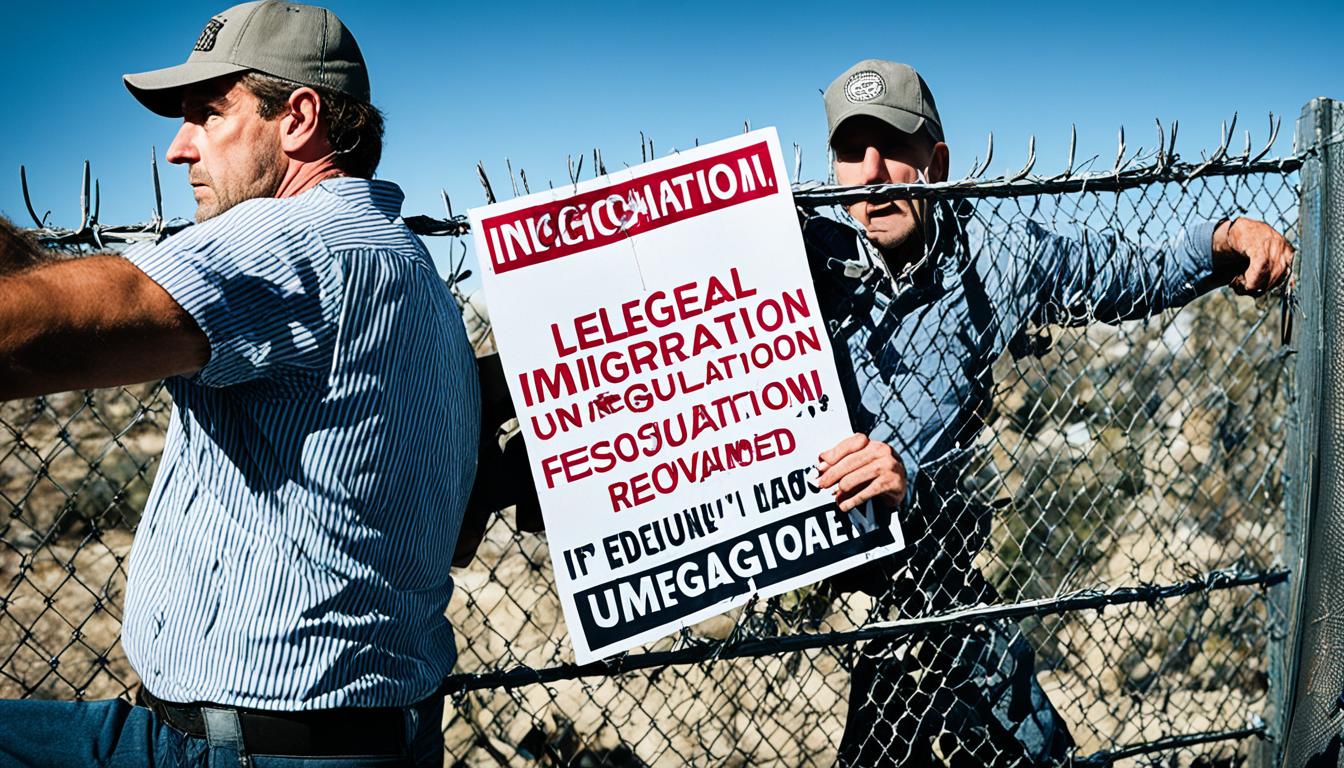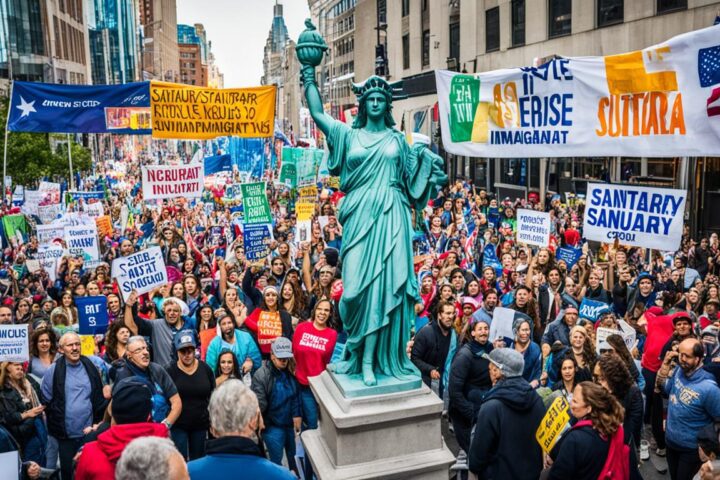The Illegal Immigration Reform and Immigrant Responsibility Act of 1996 (IIRAIRA) was a landmark U.S. immigration law. It made U.S. immigration laws tougher. It added penalties for those who lived in the U.S. without permission and committed crimes. The goal was to make U.S. borders more secure, increase enforcement inside the U.S., and make deporting people easier.
Key Takeaways
- The IIRAIRA was enacted in 1996 to strengthen US immigration laws and enforcement.
- The Act increased penalties for immigration-related crimes and grounds for deportation of undocumented immigrants.
- It mandated greater border security measures, such as increasing the number of Border Patrol agents and physical barriers.
- The Act streamlined the deportation process through the use of removal proceedings and the notice to appear (NTA) system.
- The IIRAIRA built upon previous immigration reform efforts like the Immigration Reform and Control Act of 1986.
Overview of the Illegal Immigration Reform
The Illegal Immigration Reform and Immigrant Responsibility Act of 1996 (IIRAIRA) was a big step in US immigration law. It aimed to tackle illegal immigration by making borders stronger and by changing how we deal with lawbreakers. This act was a key part of the US’s efforts to control its borders better.
Key Provisions of the Act
The IIRAIRA had several important goals. It wanted more border patrol agents, better tools, and tech for them to use. It also wanted to make the rules for kicking out illegal immigrants clearer and easier to follow.
Purpose and Objectives
This act’s main goals were to stop illegal entry, fight against human smuggling, and lower the number of undocumented people in the US. By toughening up border control and making it easier to deport those who broke the law, this act aimed to keep the US’s immigration process fair and just.
Strengthening Border Controls
The IIRAIRA improved border security and fought illegal immigration. It increased penalties for crimes such as alien smuggling and using fake documents. It aimed to reduce illegal immigration through stricter enforcement.
Increased Penalties for Immigration-Related Crimes
The IIRAIRA increased penalties for those aiding illegal immigration. It made border security and immigration enforcement a priority. This meant tougher prison sentences and bigger fines for illegal activities.
Recent data shows illegal border crossings have dropped more than half in six years. Also, border apprehensions are at their lowest level since the 1970s. This proves the IIRAIRA’s efforts have been successful in controlling illegal activity.
Yet, the fight against illegal immigration and its crimes is ongoing. Leaders are still working to improve border security. They’re also pushing harder against criminal organizations aiding illegal immigration.
Deportation and Removal Policies
The Illegal Immigration Reform and Immigrant Responsibility Act (IIRAIRA) made it easier to deport undocumented immigrants from the U.S. It allowed deportation for minor offenses, along with felonies. The law changed the game, targeting those with even small violations.
Grounds for Deportation
Thanks to IIRAIRA, many offenses can get an immigrant deported. Yes, even felonies and misdemeanors count. Recently, the number of deportation cases has soared. The Justice Department has been much busier with these cases of late.
The costs of dealing with these offenses are huge. We’re talking over $7 billion in the last ten years. No wonder they’re considered the most prosecuted crimes today. And under Trump, the focus on these cases has intensified.
An eye-opening 1.19 million people have orders to leave the U.S. But they’re still here. The reasons vary, from not finding them to executive decisions. In 2020, more than four in ten deportations were swift, with another four due to previous cases.
Restrictions on Asylum Applications
The Illegal Immigration Reform and Immigrant Responsibility Act (IIRAIRA) changed asylum rules in the US. It made a big change by setting a one-year time limit to apply for asylum. Before this, there was no strict deadline for applying.
When more than 2,500 people a day arrive at the US-Mexico border, new rules will start. Arrests in illegal border crossings are expected to increase in the summer. These rules will slow down the asylum process. They come from a 1952 law called 212(f). This law lets the government control who can apply for asylum. But, it’s making handling migrant issues hard for Customs and Border Protection.
The ACLU is fighting against these new rules in court, saying they’re against the law. Even though there’s a legal battle, the rules are still happening. This shows that the full effects on asylum and immigration in the US are uncertain.
The IIRAIRA’s changes have placed new limits on asylum applications in the US. With more people crossing the border than ever, these rules are a key part of the US’s immigration reform. Yet, their real impact and if they follow US laws will be closely watched in the coming days.
Employer Sanctions and the I-9 Form
The Illegal Immigration Reform and Immigrant Responsibility Act (IIRAIRA) has strict rules for employers. It targets those hiring undocumented workers. If found guilty, employers face both civil fines and criminal charges.
Penalties for Hiring Undocumented Workers
Every employer must check that new hires can legally work. They need to fill out and keep a Form I-9 for each since 1986. This form proves an employee’s eligibility. Employers can’t treat people differently because of their birth country, if they are a citizen, or their immigration status.
Breaking these rules comes with serious consequences. Employers could pay fines, face criminal charges, or lose the right to do government work. They might also have to fix things by paying back wages or giving jobs to those they treated unfairly. Key offenses include hiring those without legal authorization, not doing the Form I-9 checks, and mistreatment like document fraud and discrimination.
Employment Eligibility Verification Process
The I-9 form has five parts and is for checking employees’ right to work. This includes workers’ details, checking their documents, lists of acceptable IDs, and more. For U.S. employers, the form must be filled out in English. However, in Puerto Rico, they may use a version in Spanish.
The Immigration Reform and Control Act of 1986 (IRCA) put the I-9 form in place for employees starting November 6, 1986. Later legislation fine-tuned these procedures, requiring extra safety features on some documents and updating what is accepted.
The IIRAIRA also created the E-Verify system. This lets employers check a new person’s right to work online. It’s based on earlier pilot projects and is now widely used.
Illegal Immigration Reform and Immigrant Responsibility Act of 1996
The Illegal Immigration Reform and Immigrant Responsibility Act (IIRAIRA) of 1996 made big changes. It was passed by Congress and signed by President Clinton. This law made the consequences for breaking immigration laws much more severe.
Key Provisions of IIRAIRA
It introduced the 287(g) program. This program let state and local police help federal agents with immigration enforcement. It meant more people could enforce immigration laws outside the federal government.
This Act also set the stage for later immigration policies, like those under President Trump. It laid down rules for removing people without legal status, cutting how many legal immigrants can come, and making sure laws were strictly followed.
Impact on Undocumented Immigrants
The IIRAIRA was hard on people who were in the US without the right papers. It made more reasons to deport them, set tougher penalties for immigration crimes, and made it harder to get legal status. Many undocumented people found their lives much tougher after this law.
In 2016, the Center for Migration Studies of New York looked into IIRAIRA’s effects. They found its impact is still felt today. It’s a big part of the talk and decisions about immigration in the US.
Historical Context and Background
In 1996, the Illegal Immigration Reform and Immigrant Responsibility Act (IIRAIRA) marked a big step on how the U.S. deals with immigration. It followed the Immigration Reform and Control Act (IRCA) of 1986, which was a major milestone. President Ronald Reagan signed the IRCA, tackling the issue of illegal immigration head-on. It brought in rules against employers hiring undocumented workers.
Immigration Reform and Control Act of 1986
The Immigration Reform and Control Act (IRCA) of 1986 was a key point in U.S. immigration policy. It worked to curb illegal immigration by penalizing employers that knowingly hired undocumented people. At the same time, the Act offered a way for certain undocumented individuals in the U.S. to gain legal status.
Among the many moves, IRCA required employers to check on new hires’ eligibility to work by filling out the I-9 form. Companies that didn’t follow these rules faced serious consequences. The act also included amnesty for undocumented residents who’d arrived before January 1, 1982. This gave them a chance to become legal residents.
IRCA made a significant impact on immigration reform in the United States. It set the stage for future laws to handle the challenges of immigration history and policy.
Immigration Statistics and Data
For years, immigration has sparked both social and political debates in the U.S. The Illegal Immigration Reform and Immigrant Responsibility Act (IIRAIRA) of 1996 marked a significant step in managing these issues. It’s vital to look at the most recent statistics and data on immigration within the country.
As of 2021, the U.S. had around 10.5 million unauthorized immigrants living there. This is lower than the highest count in 2007, which was 12.2 million. Most of these unauthorized immigrants were from Mexico. Yet, there has been a steady increase in people from Central America and parts of Asia.
In 2021, these unauthorized residents made up 3% of the U.S. population and 22% of those not born there. The number of foreign-born people, including legal and illegal immigrants, represented 14.1% of the total population. This was slightly more than the past five years.
About 4.6% of the U.S. workforce was made up of unauthorized immigrants in 2021. This share is similar to what it was in 2017. Over 7.8 million unauthorized workers were in the U.S. in 2021. While this was more than in 2019, it was fewer than in the past.
How people feel about immigration is also quite interesting. In 2023, 41% of those asked wanted less immigration. Meanwhile, 31% thought things should stay as they are, and 26% preferred more. These stats highlight the varied opinions and ongoing discussions on immigration in the U.S.
Conclusion
The year 1996 saw a big change in how the US handled immigration with the IIRAIRA. It took a tough stance to deal with immigrants who were not authorized. This new law aimed to make it harder for people to enter the country without permission. It also put more controls at the borders, increased the punishment for breaking immigration laws, broadened why someone could be sent back, and made it tougher to apply for asylum.
Despite these efforts, illegal immigration remains a tough problem due to many reasons. Variations in national security, job markets, and the situation of immigrants are all important to consider. Decision-makers and those directly affected are still working to figure out the best ways forward. This involves treating the matter with care and using facts to guide policies.
When thinking about the US immigration system, I see the big role that facts and studies have. They help make better decisions. For example, there are about 10.5 million people living in the US without legal status. If all of them were to be suddenly sent back, the economy could lose about $1.6 trillion dollars. These numbers show how deeply connected immigration is to the country’s future. So, it’s crucial to handle reform wisely, taking into account all kinds of viewpoints for the country’s long-term wellbeing.

















I visited multiple sites but the audio feature for audio songs
present at this site is actually superb.
Have you ever considered about adding a little bit more than just your articles?
I mean, what you say is valuable and all. But just imagine if
you added some great pictures or video clips to give your posts
more, “pop”! Your content is excellent but with pics and videos, this website could certainly be one of the greatest in its
niche. Terrific blog!
When someone writes an post he/she keeps the image of a user
in his/her mind that how a user can be aware of it. Therefore that’s
why this post is amazing. Thanks!
My family members every time say that I am killing my time here at net,
however I know I am getting experience daily by reading such
nice articles.
I am actually glad to read this blog posts which consists of tons
of useful information, thanks for providing such data.
Greetings! This is my first visit to your blog! We are a group of
volunteers and starting a new project in a community in the same niche.
Your blog provided us useful information to work on. You
have done a extraordinary job!
Hey! Do you know if they make any plugins to help with SEO?
I’m trying to get my blog to rank for some targeted keywords but
I’m not seeing very good gains. If you know of any please share.
Kudos!
Great beat ! I would like to apprentice while you amend your website, how could i subscribe for a blog
website? The account helped me a appropriate deal. I were tiny bit familiar of this your broadcast provided shiny transparent concept
I’m really impressed with your writing skills and also with the layout on your blog.
Is this a paid theme or did you modify it yourself? Anyway
keep up the nice quality writing, it is rare to see a great blog like this one
today.
Saved as a favorite, I really like your web site!
Fantastic goods from you, man. I’ve understand your stuff previous to and you are just extremely wonderful.
I actually like what you have acquired here, certainly like
what you are saying and the way in which you say it.
You make it entertaining and you still care for to
keep it smart. I can’t wait to read much more from you. This is
really a tremendous web site.
It’s not my first time to go to see this web site, i am browsing this website dailly
and take good information from here everyday.
hi!,I like your writing so a lot! proportion we keep up a correspondence extra approximately your article on AOL?
I require a specialist on this area to solve my problem.
Maybe that’s you! Taking a look forward to look you.
bookmarked!!, I really like your web site!
Hello there, You have done a fantastic job. I will certainly digg
it and personally suggest to my friends. I’m confident they’ll be benefited from this website.
Hello my friend! I wish to say that this post is awesome,
great written and come with almost all vital infos.
I would like to look extra posts like this .
Heya i am for the first time here. I came across this board
and I find It really useful & it helped me out much. I hope to give something back and
help others like you aided me.